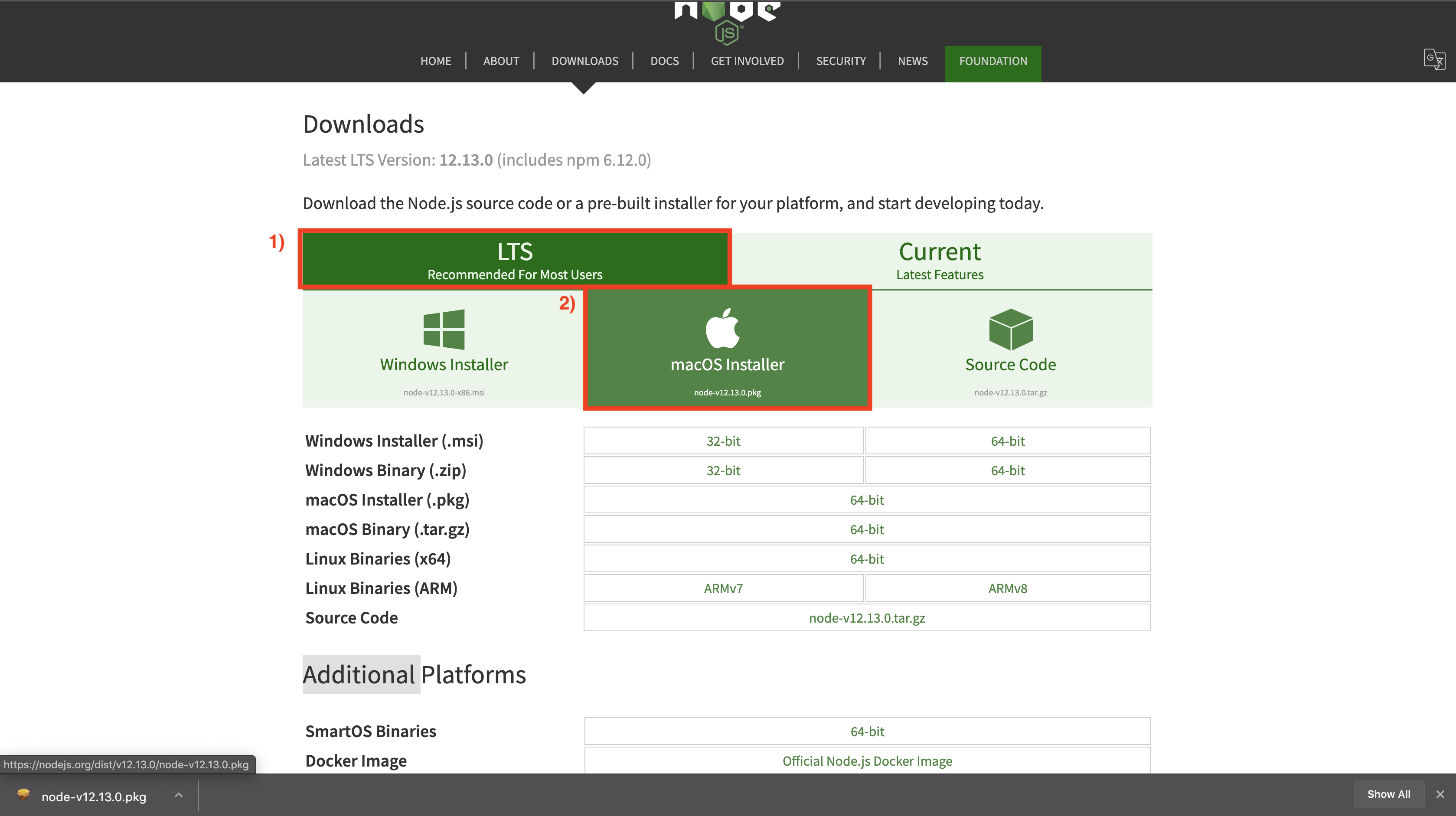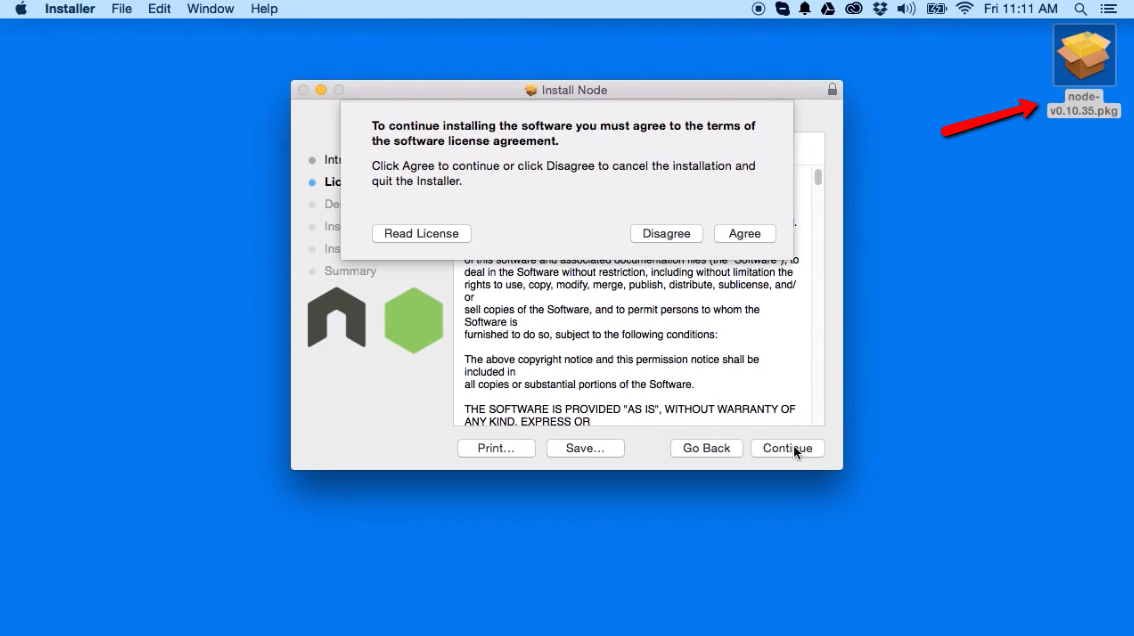Install the EB CLI with homebrew Install Python, pip, and the EB CLI on macOS Install the EB CLI on macOS If you use the Homebrew package manager, you can install the EB CLI.
As with any programming language, platform, or tool, the first step to using it is getting it installed. Many of them typically come with a speedy way to upgrade when a new version is available.
By default, there's not a way to upgrade the version of Node.js you've got from within Node.js itself. That said, there's a fantastic tool for the community called nvm that allows you to manage the versions of Node.js that you've got installed locally.
- Mac npm install permission denied. Where does npm install packages? How can I update NodeJS and NPM to the next versions? Find the version of an installed npm package. How to uninstall npm modules in node js? How to install a previous exact version of a NPM.
- That’s all—there are no external dependencies and nothing else you need to install. Install Anywhere (npm) If you use Node.js, you can also install Sass using npm by running. Install on Mac OS X or Linux (Homebrew) If you use the Homebrew package manager for Mac OS X or Linux, you can install.
One awesome aspect of nvm is that it manages the versions of Node.js, it doesn't just upgrade them. This means you can have the latest version of Node.js, the latest versions of all the LTS release lines, and any number of other versions you want to use or test as well.
In this quick tutorial, we'll take a look at how to install nvm, and then how to start using it as your version manager for Node.js. Once we've completed the tutorial, you'll be ready to take the next step with Node.js.
This guide covers installing nvm on macOS and Linux - note that all versions of Node.js may not support every version of macOS or Linux.
Step 0: The Quick Guide (TL;DR) to Get Node.js Installed using nvm
Here's the abbreviated guide, highlighting the major steps:
- Download the nvm install script via cURL:
curl -o- https://raw.githubusercontent.com/creationix/nvm/v0.33.0/install.sh | bash
- Ensure that nvm was installed correctly with
nvm --version, which should return the version of nvm installed. - Install the version of Node.js you want
- Install the latest version with
nvm install node - Use the latest version with
nvm use node - Install the latest LTS version with
nvm install --lts - Use the latest LTS verison with
nvm use --lts
- Install the latest version with
Step 1 (Optional): Ensure your system has the appropriate C++ compiler
In some cases, like when installing Node.js releases from their source or installing versions of Node.js before0.8.6 (when the project started shipping binaries), you'll need to ensure that your system has the appropriate C++ build tools.
For LTS and modern releases, you will not need this step. That said, it's a nice to have to ensure that the majority of requirements are met in any scenario.
On macOS, you've got two options for a C++ compiler: the full XCode application or the stand-alone Command Line Tools portion of Xcode.
To get these on macOS, you can follow these steps:
- Open your terminal of choice
- Run
xcode-select --installas a command- A popup will appear
- Select
Install
- Allow the download to run to completion
- If the installation went uninterrupted, you should have the necessary tools to use nvm!
On Linux, the C++ compiler will vary from distribution to distribution. For example, on Debian and Ubuntu, you'll need to install build-tools and libssl-dev, but this may be different on your given Linux distribution.
To get build-tools and libssl-dev on Debuan and Ubuntu distributions, you can run these commands:
Step 2: Download nvm with the install script
Once you've got the right C++ compiler for your system, now it's time to run the nvm install script. Here are the single-step install scripts for both macOS and Linux. You've got the option of cURL or Wget but both achieve the same result.
Note: If your Linux system doesn't have either cURL or Wget, you can run sudo apt-get install curl and use the cURL method.

Running the Install Script with cURL:
Npm On Mac
To install nvm with the cURL method, run the following command in your terminal:
Using the Install Script with Wget:
To install nvm with the Wget method, run the following command in your terminal:
Step 3: Verify that nvm was Properly installed
After running the install script from Step 2, nvm should have successfully installed. To ensure that nvm is up and running on your machine, you can test it with the following command:
This command will return something like (though not necessarily exactly) the following:
Missing the nvm command after running the install script?

If you're using macOS, you may be missing a .bash_profile file - to troubleshoot this, you can run touch ~/.bash_profile in your command line and re-run the installer script.
If the problem persists after that, you can open the existing .bash_profile file (using your favorite text editor) and add the following line to it:
If you're still having issues, you can take a peek at this issue to find a discussion of the problem and a collection of possible resolutions.
Step 3: Using nvm to manage Node.js
Congratulations! You've now got nvm - a tool to easily allow you to manage and swap out the versions of Node.js you've got installed locally. Now, let's get you started with doing just that.
Install the latest Node.js version
To install the latest available version of Node.js, you can use the following command:
Next, to use that version of Node.js in any new shell, you can simply run the use command:
Install the latest Node.js LTS version
To install the latest available LTS version of Node.js, you can run the following command:
And to use that latatestTS version of Node.js in any new shell, you can simply run the use command:
Step 6: Go build applications, APIs, tools, and more with Node.js!
Now you've got a fantastic version manager for Node.js. It's time to start building!
We've got some resources to get you kickstarted! Both the breadth and depth of the Node.js and the JavaScript ecosystems are quite large - in addition to the developer tools like NodeSource N|Solid and Certified Modules, we've got a ton of tutorials, guides, and articles to help you get kick started with Node.js.
If you're interested in keeping your code clean, maintainable, and collaborative, take a peek at our post on using ESLint for linting your JavaScript applications. Are you interested in building web applications with Node.js? One of the most challenging aspects of web apps is security - you can learn security best practices for Express to lock down your web apps, to prevent breaches and attacks. Or, maybe you want to deploy your Node.js apps with Docker? Then you should definitely read our article on dockerizing your Node.js applications.

That said, if you want to keep in touch with the Node.js ecosystem, you should follow @NodeSource on Twitter! We'll keep you updated with important news from the core Node.js project, fresh and useful Node.js tutorials, and more.

As a developer or web designer, we use NPM almost more than 5 times on average per day. Sometimes, it takes a long time to install a package. Even more than 5 minutes or more. Besides, you watch some people on tutorials who install a package in 5 seconds. How they do that? If you want to make NPM install Work 20 times faster, this tutorial will help you.
Why NPM install is Too Slow?
Before we make NPM work faster, we should know what are the reasons why NPM install is too Slow. Well, there are many reasons. We just mention a few of them. So, if you are using Mac, it’s faster than the PC. Because all Apple MacBooks are having SSD hard drive. Also, most SSD drives are 5 to 10 times faster than HDD hard drives. Therefore, your computer might work slow.
If you have Mac or PC with SSD hard drive and still your NPM install command work slow, you can make it faster by following the tutorial. Also, this method works for HDD drives as well.
Make NPM InstallWork 20 Times Faster
1. The first way to make NPM install faster is to make the progress set to false. So, this makes NPM install packages without showing the progress status.
It makes NPM install run 2x faster.
2. The second way is to use PNPM. It’s fast, disk space-efficient package manager. Besides, it’s a lot faster than NPM and Yarn. The way it works is similar to NPM. Also, as the documentation says, it supports almost 80% of NPM commands.
Features:
- Fast. Faster than NPM and Yarn.
- Efficient. One version of a package is saved only ever once on a disk.
- Deterministic. It has a lock file called.
shrinkwrap.yaml - Strict. A package can access only dependencies that are specified in its.
package.json - Works everywhere. Works on Windows, Linux and OS X.
Here is how you install and use it. Assuming you have NPM.
Now, instead of using NPM install, use PNPM install. For example.
But you should remember, it will not work if you don’t have the filepackage.json.
Before using PNPM install command, run npm init -y to create an empty package.jsonfile.
NPM commands that are re-implemented in PNPM:
installupdateuninstalllinkprunelistinstall-testoutdatedrebuildroothelp
Npm Install Mac Os X
You can read more here about it.

Conclusion
I hope it has been informative for you and y help you. If you have any questions, feel free to comment below. Besides, you can join our forum and ask questions there.
